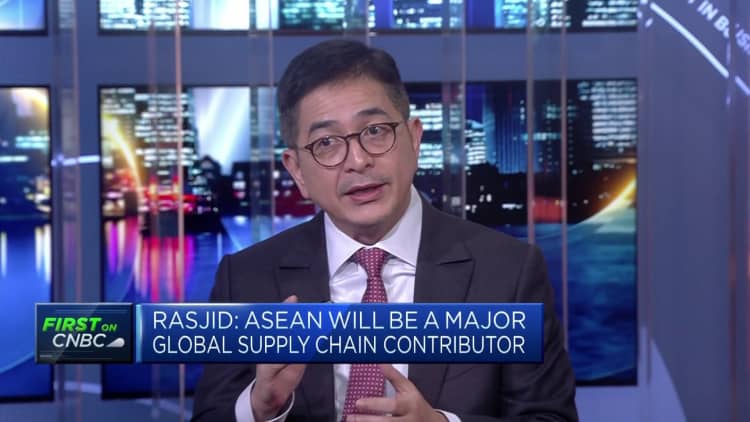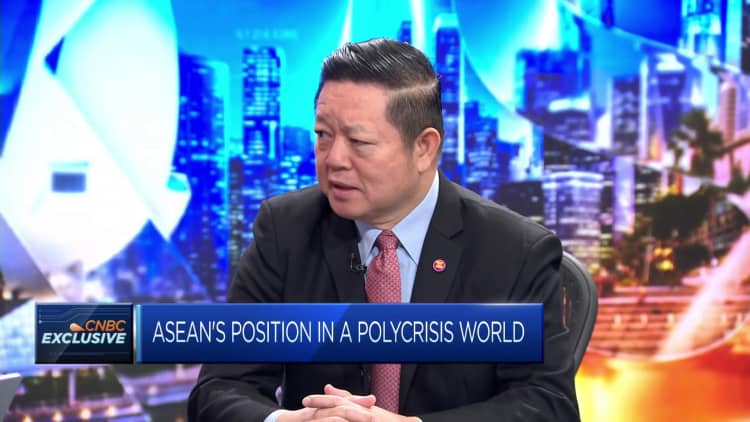Indian Army T-90 Bheeshma tanks roll past during the full dress final rehearsal for the Indian Republic Day parade in New Delhi on January 23, 2009. (Photo credit RAVEENDRAN/AFP via Getty Images)
Raveendran | Afp | Getty Images
India is taking major strides to expand its influence in Southeast Asia, a move that will allow countries to counter China’s dominance in the region.
“India certainly is becoming more ambitious in Southeast Asia. There is no doubt about it,” said Harsh V. Pant, vice president for studies and foreign policy at Observer Research Foundation, a New Delhi-based think tank.
It has also become “more forceful and more upfront” about its ties with the region, he added.
Growing rivalry between India and China is seen as influencing New Delhi’s strategic calculation in strengthening its presence.
For a long time, Indian leaders had been “hesitant and reticent” about the country’s role in the region, due to its own tensions with China along the Himalayan border, noted Pant.
Relations have been fraught since a border clash with Chinese forces in 2020, which killed at least 20 Indian soldiers, according to the Indian army.
“I think the understanding in New Delhi had been: Let’s not wade into waters where China might be more uncomfortable,” Pant told CNBC, adding that Beijing has “enormous potential to create trouble for India.”

Since China hasn’t “budged” on the border issue, India “now feels there has been no real return for its cautious attitude towards Southeast Asia,” he added.
India’s foreign ministry did not respond to CNBC’s request for comment.
In June, India’s external affairs minister Subrahmanyam Jaishankar, highlighted the border conflict was affecting relations between the two countries.
Until Sino-India relations achieve “some sense of normalcy,” Pant said, New Delhi has few options but to ramp up ties with countries — “big or small around China’s periphery, to ensure it has some leverage.”
Tightening ties
In recent months, Prime Minister Narendra Modi’s government has stepped up its outreach to regional countries aimed at balancing Beijing’s aggression.
The move reinforces India’s ongoing comprehensive strategic partnership with Southeast Asia.
In June, New Delhi said it was giving a naval warship to Vietnam, in the latest sign of growing defense ties between both nations, said Satoru Nagao, non-resident fellow at Hudson Institute, based in Tokyo.
“India also trains pilots and ground crew of fighter jets of the Vietnam Air Force. Indian naval ships visited Vietnam constantly,” he added.
Vietnam is now planning to buy supersonic missiles and surface-to-air missiles from India, said Nagao, who specializes in defense strategy, foreign policy and security alliances.
“India’s ‘Look East’ policy began in 1991, well before China’s growing assertiveness was a real problem in Southeast Asia,” said Derek Grossman, a senior defense analyst at the Rand Corporation.
“But by 2014, when Modi turned the policy into ‘Act East,’ it was apparent that the region and world was dealing with a different kind of China — Xi’s China — which sought to flex its power more often and farther from Chinese shores,” he said referring to Chinese leader Xi Jinping.
Activists display anti-China placards and flags during a protest at a park in Manila on June 18, 2019, after a Chinese vessel last week collided with a Philippine fishing boat which sank in the disputed South China Sea and sailed away sparking outrage. Photo by TED ALJIBE / AFP) (Photo by TED ALJIBE/AFP via Getty Images)
Ted Aljibe | Afp | Getty Images
India caused a stir in late June when its foreign minister and his Filipino counterpart, Enrique Manalo, issued a joint statement, urging China to abide by The Hague’s 2016 arbitration decision on the South China Sea.
The joint statement sparked speculation that New Delhi was shifting away from its neutral posture on competing territorial claims in the region.
In a landmark ruling on the South China Sea dispute, the international tribunal in The Hague unanimously ruled in favor of the Philippines in a historic case against China.
China has rejected the 2016 ruling, describing it as “illegal and void.”
Beijing claims almost the entire South China Sea — an assertion that is rejected by Malaysia, Vietnam, Brunei and the Philippines among others, in competing claims for the resource-rich waterway.
India “is bolstering strategic ties — diplomatic, economic, and security — to Southeast Asian states to help them balance or hedge against, or outright counter Chinese power,” said Rand’s Grossman.
“This is particularly salient to the maritime sphere, namely the South China Sea, where overlapping sovereignty disputes threaten regional stability and openness,” he added.
Complex dynamic
China’s expanding influence through its Belt and Road Initiative in Southeast Asia is also driving India’s calculation, according to Joanne Lin, co-coordinator of the ASEAN Studies Centre at ISEAS, at Yusof Ishak Institute in Singapore.
As a result, “safeguarding India’s security, especially maritime security will be important,” Lin added.
Most countries in the region have supported China’s mega infrastructure project — Xi’s signature policy initiative aimed at expanding Beijing’s influence through a network of road, rail and sea connections across Asia, Europe and the Middle East.
Observers note Beijing’s more strident foreign policy, coupled with the political and economic leverage it could exert through the Belt and Road, has raised concerns in the region.
India is not a camp follower of either side. It continues to maintain a very independent streak in its foreign policy, which suits a large number of Southeast Asian countries.
Harsh V. Pant
Observer Research Foundation
Readjusting to an evolving international order defined primarily by the China-U.S. rivalry has also proven particularly challenging for Southeast Asian countries.
Regional countries are “engaging India because it is a power in its own right,” noted Prashanth Parameswaran, a fellow at the Wilson Center and founder of the weekly ASEAN Wonk newsletter.
They see India as an “important piece of a broader strategy of shaping a more multipolar order rather than one that is centered around China or dominated by U.S.-China bipolar competition,” he added.
A regional survey published by the ASEAN Studies Centre at the ISEAS-Yusof Ishak Institute showed India’s standing has improved greatly among Southeast Asian nations, despite its neutral stance in Russia’s war against Ukraine.
“India is the third top option for the region in hedging against the uncertainties of the US-China rivalry. Its ranking more than doubled from the last spot in 2022 to the third spot this year,” said ISEAS’s Lin, one of the authors of the survey.
‘A way out’
Observers say that New Delhi also offers “a way out” for countries that seek to remain neutral in the U.S.-China conflict.
“India is not a camp follower of either side,” said Pant from New Delhi’s Observer Research Foundation. “It continues to maintain a very independent streak in its foreign policy, which suits a large number of Southeast Asian countries.”
While China remained the most influential and strategic power in Southeast Asia, its standing has diminished, the Southeast Asia survey from February showed.

China continues to be regarded as the most influential economic power by 59.9% of the respondents. However, its influence has declined significantly from 76.7% in 2022, as countries grew more wary of Beijing.
For several states that “most distrust China in the region — namely the Philippines, Vietnam, Indonesia, and Singapore,” India is “an additional partner to help counter Beijing,” noted Rand’s Grossman.
Still, New Delhi’s latest moves to deepen regional ties won’t go unnoticed by Chinese leaders, analysts noted.
China will be “cautious” about the developments, said Lin from ISEAS. “India’s growing influence in Southeast Asia and enhanced defense cooperation,” among other issues “will cause unease in Beijing,” she added.
Pant noted: “China will be watching this carefully and sending its own messages out.”
But given Southeast Asia “is a central pillar to India’s own Indo-Pacific strategy,” that will not deter New Delhi,” he added. “India’s push into the region will only continue to gather momentum.”
 EU News Digest Latest News & Updates
EU News Digest Latest News & Updates


